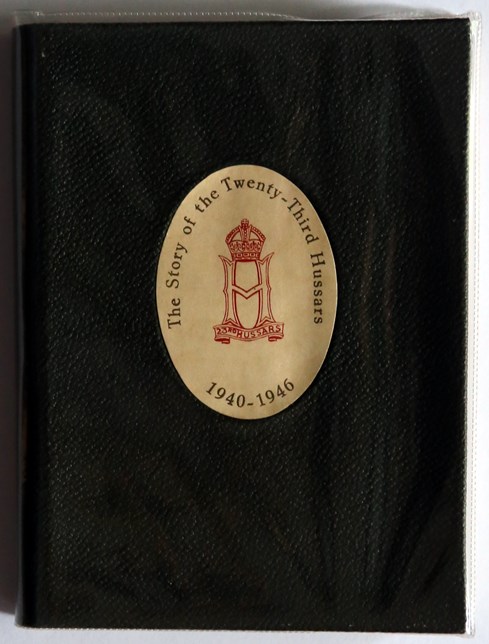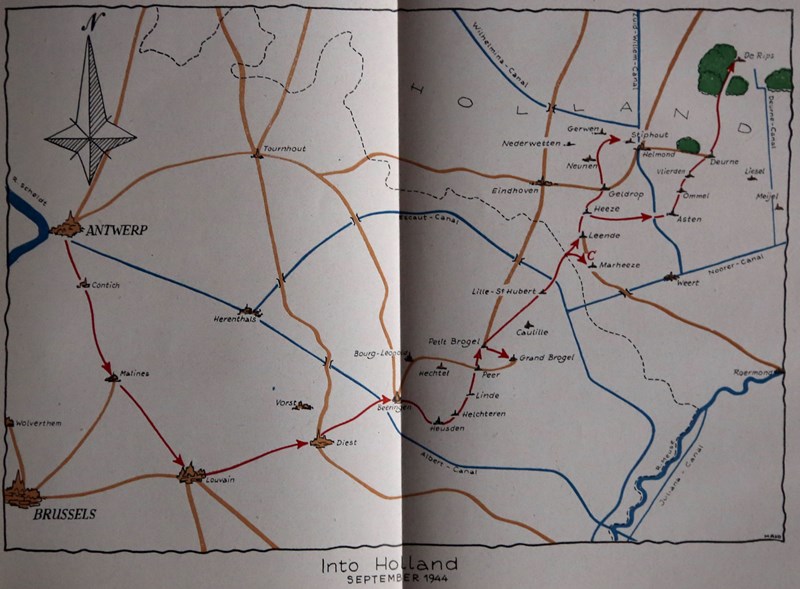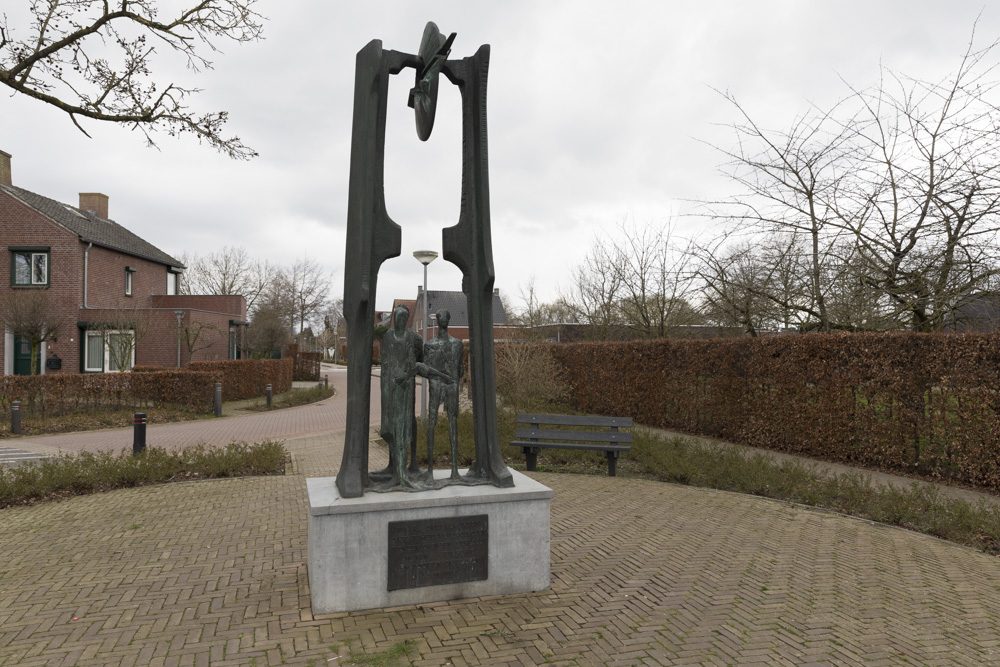Liberation of Helmond
This is an extract from 'The Story of the 23rd Hussars 1940-1946' published in 1946. This story relates to the liberation of Stiphout and Helmond between 22 and 25 September 1944.
On the 21st we were ordered to continue northward through Geldrop and across the railway linking Eindhoven and Helmond. The latter was reported to be held by a large force of tanks and infantry, some of which were believed to be ahead of us at Nunen, Gerwen and Nederwetten. Towards three o'clock 'A' Squadron and 'G' Company were detached and sent out to the western flank to take Gerwen from the Nederwetten side. 'B' Squadron with 'F' Company led the rest of the Regiment. They crossed the railway without incident and entered Nunen unopposed.
But as the leading troop (Third) left the outskirts of the village enemy tanks, skilfully concealed on the south edge of Gerwen, opened fire on them knocking out Sergeant Dowling's tank and wounding all five of the crew. The Germans also covered the ground with mortars and small arms and there was some difficulty in rescuing the wounded. Lance-corporal Johnson managed to drag some of them back, showing considerable disregard for his own safety (for which he was later Mentioned-in-Despatches). Soon afterwards Sergeant Jones' tank was also hit, but luckily the crew escaped. No further progress could be made that way.
'C' Squadron was therefore sent on a reconnaissance in the Helmond direction towards a small village called Stiphout and referred to over the wireless as 'strip-tease' or 'Jane'. These code-names, invented on the spur of the moment, probably fooled as many tank commanders as enemy on some occasions! First Troop moved off and were passing down a narrow road flanked by a thin belt of trees, when the sound of tank engines coming towards them caused them to swing hurriedly off the road and hide in the trees. They waited, watching and listening intently. The sound of engines grew louder and in a few moments the dark shapes of Panthers came into view, lurching in and out of the scrub, broadside-on to our guns. First Troop held their fire. A group of Dutch peasants huddled in an evilsmelling shelter in their garden muttered and moaned wild-eyed with apprehension. Suddenly the gun-muzzles flashed and the blast of the explosion shook the leaves from the trees, and reverberated among the farm buildings. Sergeant Smith's seventeen-pounder sent up a little spurt of flame from the leading Panther. A second lurched violently and sank into the boggy ground, its immense barrel pointing skywards. Altogether three of a force of five Panthers, on their way to reinforce Gerwen, were destroyed. In view of this threat 'B' Squadron took up defensive positions in Nunen. 'A' Squadron, on the other hand, had swept round to the west side of Gerwen and advanced to within half a mile of the village before they were fired on. It was decided to launch a full-scale Squadron-Company attack, preceded by a heavy 25-pounder concentration. This took a little time to arrange. In due course, however, shells poured into the village and the attack began. The tanks moved off, but they did not go far before there were two sharp reports from the village and two Shermans went up in flames. Again there was difficulty in extricating the wounded, and this time it was Sergeant Baldwin of 'G' Company who went out under enemy fire to bring them to safety. By now it was dark and the attack was postponed until the morning. When daylight came, however, the Germans had flown.
In this area there was a larger number of enemy than we had met for some time. They were usually difficult to spot in the trees and scrub and, that night, as it grew dark, a single shot from a eighty-eight rang out behind Nunen and three RB carriers, lined up in a row, were destroyed.
This short action against the 107th Panzer Brigade – one of the latest "Pocket Panzer Division" – and a Battalion of Panzer Grenadiers was later described by the Corps Commander as having saved Eindhoven and the main supply line to Arnhem at a critical moment in that battle. The enemy force whose movement west we had so fortuitously blocked moved north the following morning and cut this route nearer to Arnhem. It was only dislodged after the whole of the Tactical Air Force had been thrown in against it. The Regiment, however, had fulfilled its task and the following morning the whole area between Helmond and Eindhoven was clear. The canal bridges, on the other hand, had all been blown.
During this time the Third Tanks were clearing the western approaches to Helmond, and the Fifes were having one of their bitterest engagements in their bridgehead over the Bois de Duc Canal at Asten. That night, therefore, we concentrated behind them, and moved through, the following morning, with 'A' Squadron and 'G' Company in the lead. As they moved out of Asten into a small hamlet called Ommel their leading troop was engaged by a hidden anti-tank gun. All that day they sat in Ommel doggedly trying to work their way out, road-bound and shelled and "minnied" throughout.
When they eventually established that they had driven back the anti-tank gun, 'C' Squadron pushed through them and reached the hamlet of Ommel Bosch without incident. From the rising ground upon which this hamlet lay could be seen the village of Vlierden. Covered by Squadron Headquarters and Second Troop the vanguard moved forward. Just as it started the Germans sent over a very heavy "minnie stonk" and among our casualties was Padre Taylor, who was later awarded the M.C. He had on this occasion, as always, been with the leading troops; no better padre could have been wished for being universally popular and an inspiration to all.
The vanguard moved cautiously on but just short of the village the leading carrier was demolished by a direct hit from what proved later to be an anti-tank gun. Light was beginning to fail and no further progress could be made that night.
At the same time as 'C' Squadron had taken up the advance, 'B' Squadron and 'F' Company had been ordered to make a wide sweep to the right to come in behind Ommel Bosch. This they succeeded in doing. Driving through rain, dense pine woods and over minor tracks, they reached the centre-line between Vlierden and Ommel Bosch. But it was too late to further the attack and they, with the 'C' Squadron group, harboured for the night.
During the day some thirty prisoners were taken – raw and lousy recruits, convalescents and ex-Marines, fighting with obstinacy born of despair. Hoping to persuade more of this desperate body to give themselves up a propaganda loudspeaker went to Ommel that night to attract them with "Lili Marlene" and give them inducements and instructions for surrender. This was used again the following day when, the enemy having left the vicinity of Ommel, a pocket of them held up our advance at the approaches to Vlierden.
'C' and 'H' had moved off half an hour before dawn. 'H' Company sent a patrol up the centre-line to see whether the Germans had withdrawn over night. They reached the village just as dawn was breaking only to be met by a withering hail of fire from the first house. This pinned them to the ground until they were relieved about an hour later under cover of an attack by Second Troop and a platoon of 'H' Company. The Germans fought pugnaciously. A vanguard of 'C' Squadron and 'H' Company commanded by Captain P. May (8 RB [The Rifle Brigade]) was sent on a right hook, whilst the remainder of the group attacked from the centre. The troops on the right made excellent progress and Lieut. Gordon-Smith was mainly responsible for their disrupting the enemy's left flank position, which enabled the vanguard to establish themselves behind Vlierden on the road to Deurne.
Meanwhile the propaganda machine was having great effect.
"Why, German soldier, oh why, be killed in the last weeks of the war?" seemed then a pertinent and compelling refrain. Seventy prisoners were taken all told.
The value of this form of bloodless warfare, however, lay more in giving instructions on the "hows" of surrender than on the "wherefores". The latter needed – or rather seemed to need – no amplification. Rarely, either then or later, did the Regiment meet such brutish, verminious, underclothed, underfed and underarmed troops. Only once again, at Venray, were similar troops encountered. Yet though these seemed to be very dregs of German man-power and though it was a fact that they were untrained, often convalescent and always abandoned by their officers, these troops more often than not clung leech-like to their positions and fired to the last round. Men have rarely sacrificed themselves so sheepishly and so willingly as cannon-fodder.
Vlierden having been cleared by midday, 'C' Squadron led on to Deurne, the Third Tanks converging on the town from the south-east. Both Regiments harboured there for a night which was disturbed by an occasional shell or "minnie".
On arrival at Deurne we heard that a German had telephoned from Helmond, claiming to be a British officer with Allied Troops in the town. Knowing that Helmond had as yet been spared what might have been a painful "liberation", it was thought worthwhile to return the compliment. The Intelligence Officer, who was alleged to be sufficiently qualified, was duly despatched and, pretending to be the Adjutant of the German garrison in Deurne, finally managed to lure the German in Helmond to the 'phone. Having been so unmasked, the German immediately retorted by accusing the IO of speaking the lingo with a "typical English slang". Unable to deny this, his conversation ended in an even more typical Teutonic slanging match. After this dangerous contest, Helmond was telephoned again the following morning: the German and all his tribe were gone. However, the 159th Infantry Brigade passed through Deurne that day to Helmond and we did not move on until midday.
It was September 25th. The Guards had failed to relieve Arnhem and the operation on which we had so hopefully been launched had failed by a hair's breadth.
The tanks rumbled on northward towards St. Antonis and the Maas. Ahead of us enemy tanks and infantry were reported to be attempting to cut across our axis eastward towards Germany. The most amusing incident for us of the move were the activities, and the Colonel's comments thereon, of our Sapper Reconnaissance Officer. Accidentally he overshot 'B' Squadron's tail without realizing it and carried out a fine piece of liberation in unsuspecting isolation. The more he reported the failure of his efforts to catch up to the Squadron he had already passed, the more vivid became the Colonel's comments on the length of 'B' Squadron's column.
After that we moved on slowly with orders to take up positions along the road running through De Rips, facing both east and west, against both the enemy in flight and against the enemy who might come back. The enemy in flight certainly intended to fight his way out. Within a few minutes of halting at De Rips we heard the frightful news that a German half-track trying to cut across our road some miles ahead had killed Colonel Silvertop of the Third Tanks and Colonel Orr of the Third Monmouthshires, and wounded the Brigadier and the Brigade Major.
Little did we dream then that we should be sitting here for the next three weeks or that the "Pocket" we had left to our right in the bend of the Maas opposite Venlo – a miserable, partially reclaimed peat-bog, known as Peelland - would keep us engaged, actively and inactively, for the next two months.
Definitielijst
- Brigade
- Consisted mostly of two or more regiments. Could operate independently or as part of a division. Sometimes they were part of a corps instead of a division. In theory a brigade consisted of 5,000 to 7,000 men.
- cannon
- Also known as gun. Often used to indicate different types of artillery.
- infantry
- Foot soldiers of a given army.
- propaganda
- Often misleading information used to gain support among supporters or to gain support. Often used to accomplish ideas and political goals.
- Regiment
- Part of a division. A division divided into a number of regiments. In the army traditionally the name of the major organised unit of one type of weapon.
- Squadron
- A military unit in the Belgian navy usually six to eight small ships operating together under one command. The smallest military unit in the Dutch air force of about 350 men. In most countries is the designation of a military unit thesize of a company. It is either an independent unit, such as a battery, or part of a bigger Calvary unit. In the air force it is the designation of a unit of aircrafts.
Images
Information
- Published by:
- Jeroen Koppes
- Published on:
- 24-08-2015
- Last edit on:
- 09-08-2016
- Feedback?
- Send it!






